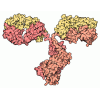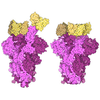+ Open data
Open data
- Basic information
Basic information
| Entry | Database: PDB / ID: 9naq | |||||||||
|---|---|---|---|---|---|---|---|---|---|---|
| Title | Cryo-EM structure of 110_C4 Fab in complex with CIDRa1.7 PfEMP1 | |||||||||
 Components Components |
| |||||||||
 Keywords Keywords | IMMUNE SYSTEM / Serum antibody / Cryo-EM / Monoclonal antibody / PfEMP1 / Malaria | |||||||||
| Function / homology |  Function and homology information Function and homology information | |||||||||
| Biological species |  Homo sapiens (human) Homo sapiens (human) | |||||||||
| Method | ELECTRON MICROSCOPY / single particle reconstruction / cryo EM / Resolution: 3.4 Å | |||||||||
 Authors Authors | Raghavan, S.S.R. / Ward, A.B. | |||||||||
| Funding support |  United States, United States,  Denmark, 2items Denmark, 2items
| |||||||||
 Citation Citation |  Journal: Proc Natl Acad Sci U S A / Year: 2025 Journal: Proc Natl Acad Sci U S A / Year: 2025Title: Identification of broadly inhibitory anti-PfEMP1 antibodies by mass spectrometry sequencing of plasma IgG from a malaria-exposed child. Authors: Louise Turner / Teresa Nunez de Villavicencio Diaz / Sai Sundar Rajan Raghavan / Ikhlaq Hussain Kana / Eric Lyimo / Chelsea Reitzel / Christian W Wang / Ewen Berube / Rasmus W Jensen / ...Authors: Louise Turner / Teresa Nunez de Villavicencio Diaz / Sai Sundar Rajan Raghavan / Ikhlaq Hussain Kana / Eric Lyimo / Chelsea Reitzel / Christian W Wang / Ewen Berube / Rasmus W Jensen / Johannes R Loeffler / Monica Lisa Fernández-Quintero / Thor G Theander / John P A Lusingu / Thierry Le Bihan / Xiaobing Han / Daniel T R Minja / Andrew B Ward / Bin Ma / Thomas Lavstsen /    Abstract: pathology is driven by the accumulation of parasite-infected erythrocytes in blood capillaries. This sequestration process is mediated by the parasite's erythrocyte membrane protein 1 (PfEMP1) ... pathology is driven by the accumulation of parasite-infected erythrocytes in blood capillaries. This sequestration process is mediated by the parasite's erythrocyte membrane protein 1 (PfEMP1) adhesins, which bind select endothelial cell receptors. A subset of PfEMP1 binding human endothelial protein C receptor (EPCR) through their cysteine-rich interdomain region alpha 1 (CIDRα1) domains drives the pathogenesis to severe malaria. Despite high sequence diversity among CIDRα1 domains, individuals living in malaria-endemic regions become immune to severe disease in part through acquisition of antibodies inhibiting the PfEMP1-EPCR interaction. Here, we demonstrate an approach to identify pathogen-specific human monoclonal antibodies from plasma, combining mass spectrometry analysis of antigen-purified polyclonal plasma IgG and Ig transcript sequencing. We identified a clonal family of broadly reactive and EPCR binding-inhibitory human monoclonal antibodies against CIDRα1. The antibodies, isolated from a 9-y-old child, exhibited potent inhibition of EPCR binding broadly across CIDRα1 domains as well as binding of infected erythrocytes to EPCR. Structural analysis of one antibody variant complexed with CIDRα1 revealed a shared epitope of the clonal antibody family overlapping the EPCR binding site and the epitopes of two previously identified monoclonal antibodies, C7 and C74, with similar functional patterns. However, although C7, C74, and 110-3 antibodies all depend on the same few residues conserved in CIDRα1 to retain EPCR binding, the 110-3 antibodies contact additional variable residues, reducing their breadth of reactivity across the CIDRα1 family. These data bolster the hypothesis that broadly inhibitory antibodies against severe malaria-associated PfEMP1 target similar epitopes and are commonly developed in malaria-exposed individuals. | |||||||||
| History |
|
- Structure visualization
Structure visualization
| Structure viewer | Molecule:  Molmil Molmil Jmol/JSmol Jmol/JSmol |
|---|
- Downloads & links
Downloads & links
- Download
Download
| PDBx/mmCIF format |  9naq.cif.gz 9naq.cif.gz | 99.5 KB | Display |  PDBx/mmCIF format PDBx/mmCIF format |
|---|---|---|---|---|
| PDB format |  pdb9naq.ent.gz pdb9naq.ent.gz | 60.6 KB | Display |  PDB format PDB format |
| PDBx/mmJSON format |  9naq.json.gz 9naq.json.gz | Tree view |  PDBx/mmJSON format PDBx/mmJSON format | |
| Others |  Other downloads Other downloads |
-Validation report
| Summary document |  9naq_validation.pdf.gz 9naq_validation.pdf.gz | 1.1 MB | Display |  wwPDB validaton report wwPDB validaton report |
|---|---|---|---|---|
| Full document |  9naq_full_validation.pdf.gz 9naq_full_validation.pdf.gz | 1.1 MB | Display | |
| Data in XML |  9naq_validation.xml.gz 9naq_validation.xml.gz | 30.5 KB | Display | |
| Data in CIF |  9naq_validation.cif.gz 9naq_validation.cif.gz | 42.3 KB | Display | |
| Arichive directory |  https://data.pdbj.org/pub/pdb/validation_reports/na/9naq https://data.pdbj.org/pub/pdb/validation_reports/na/9naq ftp://data.pdbj.org/pub/pdb/validation_reports/na/9naq ftp://data.pdbj.org/pub/pdb/validation_reports/na/9naq | HTTPS FTP |
-Related structure data
| Related structure data |  49201MC M: map data used to model this data C: citing same article ( |
|---|---|
| Similar structure data | Similarity search - Function & homology  F&H Search F&H Search |
- Links
Links
- Assembly
Assembly
| Deposited unit | 
|
|---|---|
| 1 |
|
- Components
Components
| #1: Antibody | Mass: 13228.796 Da / Num. of mol.: 1 Source method: isolated from a genetically manipulated source Source: (gene. exp.)  Homo sapiens (human) / Production host: Homo sapiens (human) / Production host:  |
|---|---|
| #2: Antibody | Mass: 11888.984 Da / Num. of mol.: 1 Source method: isolated from a genetically manipulated source Source: (gene. exp.)  Homo sapiens (human) / Production host: Homo sapiens (human) / Production host:  |
| #3: Protein | Mass: 138359.141 Da / Num. of mol.: 1 Source method: isolated from a genetically manipulated source Details: CIDRa1.7 PfEMP1 Source: (gene. exp.)  Gene: IT4_var22 / Production host:  |
| Has protein modification | Y |
-Experimental details
-Experiment
| Experiment | Method: ELECTRON MICROSCOPY |
|---|---|
| EM experiment | Aggregation state: PARTICLE / 3D reconstruction method: single particle reconstruction |
- Sample preparation
Sample preparation
| Component | Name: Complex of human serum antibody 110_C4 with CIDRa1.7 PfEMP1 Type: COMPLEX / Entity ID: all / Source: RECOMBINANT |
|---|---|
| Molecular weight | Experimental value: NO |
| Source (natural) | Organism:  Homo sapiens (human) Homo sapiens (human) |
| Source (recombinant) | Organism:  |
| Buffer solution | pH: 7.5 |
| Specimen | Embedding applied: NO / Shadowing applied: NO / Staining applied: NO / Vitrification applied: YES |
| Vitrification | Cryogen name: ETHANE |
- Electron microscopy imaging
Electron microscopy imaging
| Microscopy | Model: TFS GLACIOS |
|---|---|
| Electron gun | Electron source:  FIELD EMISSION GUN / Accelerating voltage: 200 kV / Illumination mode: FLOOD BEAM FIELD EMISSION GUN / Accelerating voltage: 200 kV / Illumination mode: FLOOD BEAM |
| Electron lens | Mode: BRIGHT FIELD / Nominal defocus max: 2200 nm / Nominal defocus min: 1000 nm |
| Image recording | Electron dose: 49 e/Å2 / Film or detector model: FEI FALCON IV (4k x 4k) |
- Processing
Processing
| EM software | Name: PHENIX / Version: 1.21_5207 / Category: model refinement | ||||||||||||||||||||||||
|---|---|---|---|---|---|---|---|---|---|---|---|---|---|---|---|---|---|---|---|---|---|---|---|---|---|
| CTF correction | Type: PHASE FLIPPING AND AMPLITUDE CORRECTION | ||||||||||||||||||||||||
| 3D reconstruction | Resolution: 3.4 Å / Resolution method: FSC 0.143 CUT-OFF / Num. of particles: 394495 / Symmetry type: POINT | ||||||||||||||||||||||||
| Refinement | Highest resolution: 3.4 Å Stereochemistry target values: REAL-SPACE (WEIGHTED MAP SUM AT ATOM CENTERS) | ||||||||||||||||||||||||
| Refine LS restraints |
|
 Movie
Movie Controller
Controller



 PDBj
PDBj

